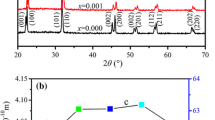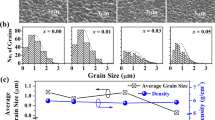Abstract
It is well known that there is a pinning effect of oxygen vacancies. The migration rate of an oxygen vacancy in crystalline ceramics is lower than the rate of spontaneous polarization, which limits the improvement of piezoelectric properties. In this work, Pr and Ce elements were introduced into position A of Na0.5Bi4.5Ti4O15 to improve the piezoelectric properties of Na0.5Bi4.2-xCexPr0.3Ti4Oy ceramics. The Ce-doping effectively modulated the content of oxygen vacancies by different doping amounts so that the difficulty of domain inversion caused by oxygen vacancy motion was reduced and insufficient polarization was improved. As a result, the best piezoelectric properties (d33 = 22 pC/N) and low dielectric loss (tan δ = 0.003) were achieved at 10 KHz under 200°C with a substitution of 0.025 mol in Na0.5Bi4.2-xCexPr0.3Ti4Oy ceramics. The high dielectric constants and low dielectric loss greatly improve the energy conversion efficiency, so this ceramic has great prospects in the application of medium- and high-frequency ultrasonic transducers.







Similar content being viewed by others
References
Y. Chen, X. Bao, C.-M. Wong, J. Cheng, H. Wu, H. Song, X. Ji, and S. Wu, PZT ceramics fabricated based on stereolithography for an ultrasound transducer array application. Ceram. Int. 44, 18 (2018).
B. Cherdhirunkorn, S. Surakulananta, J. Tangsritrakul, D. Hall, and S. Intarasiri, The Effect of nitrogen ion implantation on the physical and dielectric properties of cobalt-doped PZT ceramics. Results Phys. 16, 102851 (2020).
A.I. Dumitru, F. Clicinschi, T.-G. Dumitru, D. Patroi, J. Pintea, G. Velciu, and I. Peter, Effects of sintering temperature on structural and electrical properties of Fe3+ doping PZT ceramics. Acta Marisiensis. Ser. Technol. 17, 2 (2020).
T. Promjun, N. Funsueb, and A. Ngamjarurojana, Effect of Nb, Ta and Sb addition on structure and electrical properties of PZT ceramics. Mater. Today Proc. 17, 2019 (2019).
M. Algueró, B.L. Cheng, F. Guiu, M.J. Reece, M. Poole, and N. Alford, Degradation of the D33 piezoelectric coefficient for PZT ceramics under Static and cyclic compressive loading. J. Eur. Ceram. Soc. 21, 10 (2001).
J. Huang, M. Yao, J. Lin, and X. Yao, Enhanced mechanical properties and excellent electrical properties of PZT piezoelectric ceramics modified by YSZ. Mater. Lett. 307, 131006 (2022).
S. Li, A.S. Bhalla, R.E. Newnham, and L.E. Cross, Quantitative Evaluation of extrinsic contribution to piezoelectric coefficient D33 in ferroelectric PZT Ceramics. Mater. Lett. 17, 1 (1993).
G. Zhang, X. Chen, W. Xu, W.D. Yao, and Y. Shi, Piezoelectric property of PZT nanofibers characterized by resonant piezo-force microscopy. AIP Adv. 12, 3 (2022).
X. He, C. Chen, L. Wang, Y. Gong, R. Dun, F. Zhang, Y. Wu, H. Zeng, Y. Li, and Z. Yi, Giant electromechanical response in layered ferroelectrics enabled by asymmetric ferroelastic switching. Mater. Today. 58, 48 (2022).
M. Okayasu, Y. Sato, S. Takasu, M. Mizuno, and T. Shiraishi, Material properties of bismuth layered ferroelectrics and lead zirconate titanate piezoelectric ceramics. Ceram. Int 39, 3 (2013).
T. Takenaka and H. Nagata, Current status and prospects of lead-free piezoelectric ceramics. J. Eur. Ceram. Soc. 25, 12 (2005).
Q. Wang, Z.-P. Cao, C.-M. Wang, Q.-W. Fu, D.-F. Yin, and H.-H. Tian, Thermal stabilities of electromechanical properties in Cobalt-modified strontium bismuth titanate (SrBi4Ti4O15). J. Alloys Compd. 674, 37 (2016).
D. Hou, H. Fan, A. Zhang, Y. Jia, and W. Wang, Role of BO6 octahedral distortion on high temperature piezoelectric properties in Bi3-(Li0.5Sm0.5) TiNbO9. Ceram. Int 48, 15 (2022).
Y. Jiang, X. Jiang, C. Chen, X. Nie, X. Huang, X. Jiang, J. Zhuang, L. Zheng, and Z. Chen, Effect of tantalum substitution on the structural and electrical properties of BaBi8Ti7O27 intergrowth ceramics. Ceram. Int 46, 6 (2020).
O. Wahyudi, F. Zhang, F. Liu, and Y. Li, Morphological and phase analysis during the synthesis of Bi7Ti4NbO21 by a co-precipitation method. Ceram. Int 41, S41 (2015).
Y. Chen, Q. Luo, X.-Y. Ke, Q. Chen, H. Gong, C.-C. Zhang, X. Chen, and S.-W. Dong, Excellent high Curie temperature BiTi3O6+1.5x (x = 3.96, 3.98, 4.0, 4.02, 4.04) ferroelectric ceramics with low-loss dielectric properties. Ceram. Int 43, 17 (2017).
F. Rehman, J.-B. Li, P. Ahmed, M.S. Khan, Y. Saeed, A. Khan, and M. Zubair, Dielectric relaxation and conduction behaviors of Aurivillius Na0.5Bi4.5Ti4O15 ceramics with Na doping. Rare Met. 40, 5 (2021).
R.E. Newnham, Cation ordering in Na0.5Bi4.5Ti4O15. Mater. Res. Bull. 2, 11 (1967).
J. Yao, X. Rao, P. Du, W. Li, X. Mao, and L. Luo, Structural, Electrical and photochromic properties of Na0.5Bi4.5Ti4O15:xEr3+ ferroelectric ceramics. Ceram. Int. 48, 9 (2022).
Y. Zhang, X. Ke, K. Zhao, and Z. Zhou, R, Ca2+ Doping effects on the structural and electrical properties of Na0.5Bi4.5Ti4O15 piezoceramics. Ceram. Int. 48, 21 (2022).
Y.-G. Jeong, G.-J. Lee, S.-H. Lee, H.-S. Ma, B.-H. Kim, K.-H. Park, J.-J. Park, K. Lee, and M.-K. Lee, Piezoelectricity, thermal tstability, and fatigue resistance in Nb and Ta-doped Bi4Ti3O12 high-temperature piezoceramics. Ceram. Int 48, 9 (2022).
A.P.S. Peres, A.C.S. Costa, F. Bohn, M.A. Correa, W. Acchar, and C.A. Paskocimas, Bi4Ti3O12 multilayered ceramic tapes produced by aqueous tape casting and laminating process: structural and dielectric properties. Ceram. Int 44, 13 (2018).
W. Shi, S. Guan, X. Li, J. Xing, F. Zhang, N. Chen, Y. Wu, H. Xu, Y. Xu, and Q. Chen, Achievement of high electric performances for bismuth titanate-based piezoceramics via hot press sintering. J. Eur. Ceram. Soc. 42, 15 (2022).
S. Xie, Y. Chen, W. Liu, G. Xia, B. Huang, C. Liu, Q. Wang, and J. Li, Three-dimensional domain patterns in tetragonal-to-monoclinic Bi4Ti3O12 Ceramics: nonlinear analysis and piezoresponse force microscopy Imaging. Acta Mater. 188, 228 (2020).
F. Zhang, W. Shi, S. Guan, Y. Xu, H. Yang, H. Chen, J. Xing, H. Liu, and Q. Chen, Enhanced electrical properties and thermal stability of W/Cr Co-doped BIT-Based high-temperature piezoelectric ceramics. J. Alloys Compd. 907, 164492 (2022).
Y. Noguchi, M. Soga, M. Takahashi, and M. Miyayama, Oxygen stability and leakage current mechanism in ferroelectric La-substituted Bi4Ti3O12 single crystals. Jpn. J. Appl. Phys. 44, 9B (2005).
Y. Chen, C.-C. Zhang, L. Qin, C.-B. Jiang, K.-H. Liu, C. Ma, Z.-T. Wu, R.-K. Pan, W.-Q. Cao, C. Ye, and Z. Li, Enhanced dielectric and piezoelectric properties in Na0.5Bi4.5Ti4O15 ceramics with Pr-doping. Ceram. Int. 44, 15 (2018).
J. Liu, G. Zou, and Y. Jin, Raman scattering study of Na0.5Bi4.5Ti4O15 and its solid solutions. J. Phys. Chem. Solids 57, 11 (1996).
S. Kumar, S. Kundu, D.A. Ochoa, J.E. Garcia, and K.B.R. Varma, Raman scattering, microstructural and dielectric studies on Ba1−xCaxBi4Ti4O15 ceramics. Mater. Chem. Phys. 136(2–3), 680 (2012).
J. Shi, R. Rao, W. Tian, X. Xu, and X. Liu, Anomalous electrical performance of A-site double-bivalent-doped Bi0.49Na0.5TiO3-ceramics from nominal oxygen deficiency to excess. Ceram. Int 48, 4 (2022).
A. Peláiz-Barranco and J.D.S. Guerr, Dielectric relaxation related to single-ionized oxygen vacancies in (Pb1−xLax)(Zr0.90Ti0.10)1–x/4O3 ceramics. Mater. Res. Bull. 45, 9 (2010).
D. Wang, Y. Xu, Y. Shi, H. Wang, X. Wu, C. Wu, J. Zhu, and Q. Chen, The structure and electrical properties of Ca0.6(Li0.5Bi0.5-xPrx)0.4Bi2Nb2O9 high-temperature piezoelectric ceramics. J. Am. Ceram. Soc. 103, 1 (2020).
Acknowledgments
This work was supported by the National Science Foundation of China (Grant Nos. 52272107, 52102128) and the Key Research Development Program of Wuhan (Grant No. 2022012202015055).
Author information
Authors and Affiliations
Corresponding authors
Ethics declarations
Conflict of interest
The authors declare no conflict of interest.
Additional information
Publisher's Note
Springer Nature remains neutral with regard to jurisdictional claims in published maps and institutional affiliations.
Rights and permissions
Springer Nature or its licensor (e.g. a society or other partner) holds exclusive rights to this article under a publishing agreement with the author(s) or other rightsholder(s); author self-archiving of the accepted manuscript version of this article is solely governed by the terms of such publishing agreement and applicable law.
About this article
Cite this article
Niu, H., Fan, D., Mo, W. et al. Excellent Piezoelectric Properties of NBT-Based Lead-Free Ceramics Through Regulation of Oxygen Vacancies. J. Electron. Mater. 52, 7280–7289 (2023). https://doi.org/10.1007/s11664-023-10626-0
Received:
Accepted:
Published:
Issue Date:
DOI: https://doi.org/10.1007/s11664-023-10626-0




